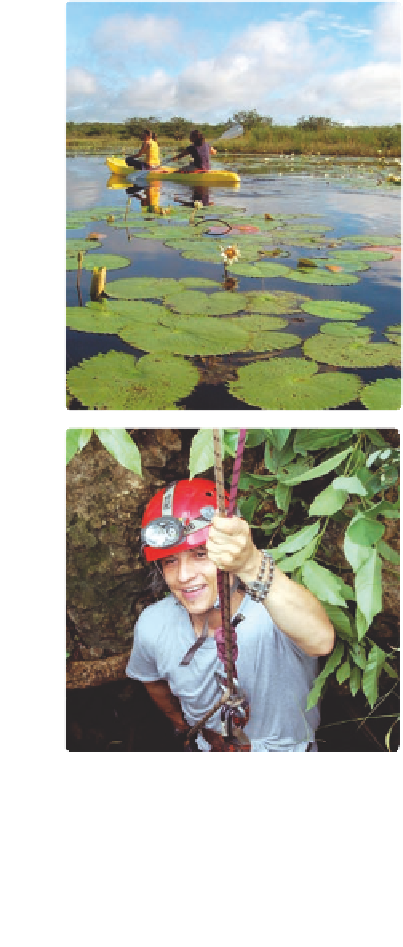Travel Reference
In-Depth Information
and animals; as such the name suggests that
the association will help to sow the seeds of
sustainable development in these poor rural
communities. By taking part in their tours,
you'll help this enterprising initiative to make a
genuine difference to the lives of the people they
support.
310 day-trips with a
diFFerence at puerta verde,
Mexico
Mountain biking through the jungle, swimming
with whale sharks, kayaking in lagoons,
trekking to Mayan ruins: these are the kinds
of activities you'd probably expect to find in the
Yucatán, but the day-trips organized by Kanché
take you away from the crowds of a typical
Cancún resort package and into the more remote
parts of the peninsula.
Kanché works with fourteen co-operatives
from rural communities in the north of Yucatán:
twelve in the municipality of Lázaro Cárdenas
(Quintana Roo) and two in
the municipality of Valladolid
(Yucatán). Four types of
excursions are offered,
though you can combine the
itineraries and do them all in
one go, staying out for three
nights in cabins and with
local families.
On the first day you'll be
taken to the caves of Nuevo
Durango, where you will
first visit a spider-monkey
sanctuary and a Mayan music
festival at Campamento
Hidalgo. Day two includes
climbing into the caves (with
helmets, lamps, harnesses
and rope), followed by
mountain biking through the
jungle, while on the third and
fourth days you'll kayak in
lagoons, take boat trips out to
Isla Pájaros and camp out in
the jungle, including a night
expedition to see crocodiles.
The term “kanché” is used
by the Maya to describe a
wooden seed germinator that
protects buds from insects
Need to know
Tours include transportation, meals
and bilingual guides. For itineraries, prices and
reservations see
W
www.kanche.org;
T
+52 998
892 7767.
Kayaking and caving are just
some of the activities Kanché
offer that take you to less
touristy parts of the Yucatán
peninsula
311 pueBlos MancoMunados,
Mexico
Pine forests, wild mushrooms and a sunrise
above clouds: not what you might associate
with Mexico, better known for beaches, colonial
cities and Aztec ruins. The mountains of the
Sierra Norte, two hours' bus journey north of
Oaxaca, are home to a cluster of villages, a
semi-autonomous community known as “Pueblos
Mancomunados” (meaning “united villages”),
where you can stay in simple adobe
cabañas
called “tourist yu'u” (pronounced “you”). This
tourist accommodation is a community business
venture that has provided an alternative to
logging and helped develop schools, roads and
health posts in the region.
Here, at nearly 3000m altitude, it is cool but
often sunny and, if abundant growth of lichen
is proof, the air is exceptionally clean. After
resting in a hammock, admiring the alpine
scenery, you'll probably want to head off for an
adventure. A guide from one of the villages will
lead you through dappled groves on mountain
bikes, horses or on foot, across kilometres
of trails through pine forests, villages and
valleys up to rocky viewpoints. The flora and
fauna ranges by altitude and includes several
endangered mammals, such as jaguar, spider
monkey and tapir. In summer, you can pick
baskets of wild shiitake or cep mushrooms.
Afterwards, sweat it out in a herb-scented
temazcal
- a Mexican sauna - before heading























Search WWH ::

Custom Search